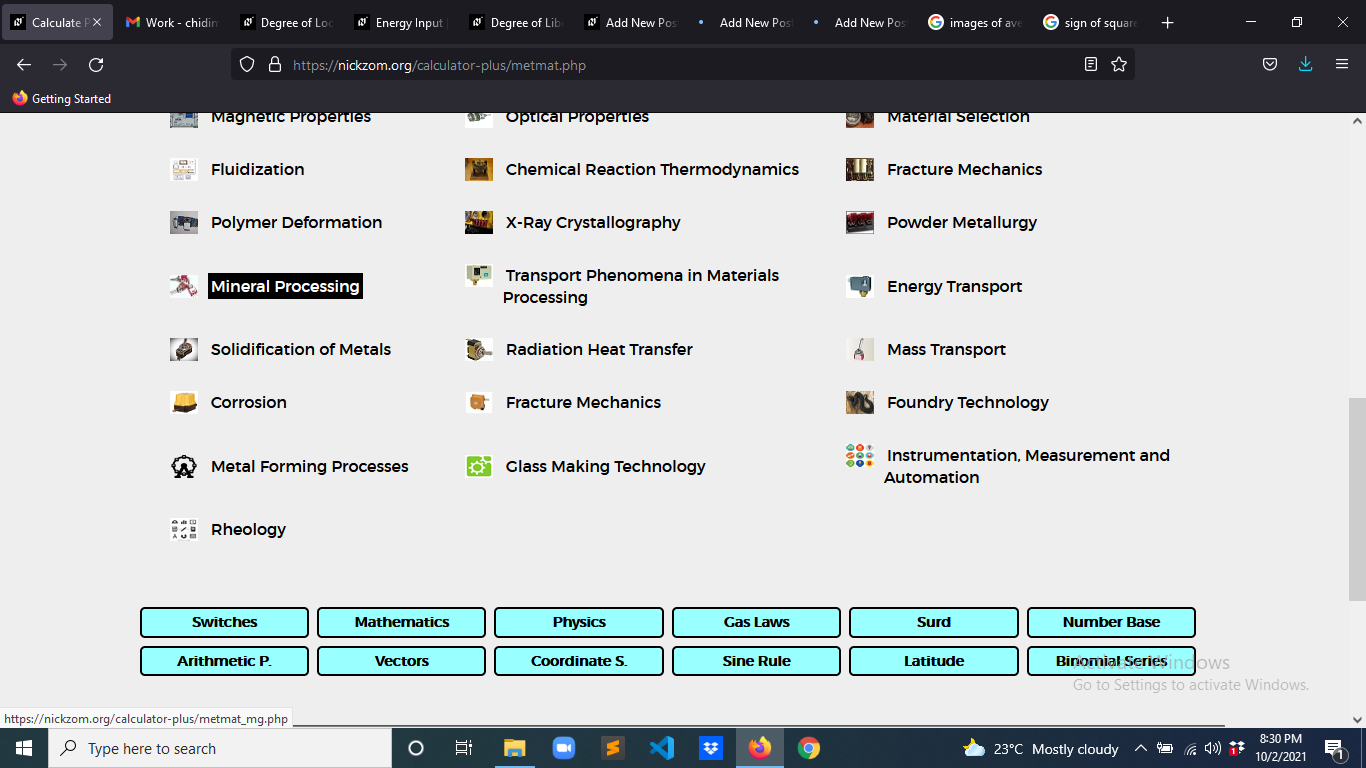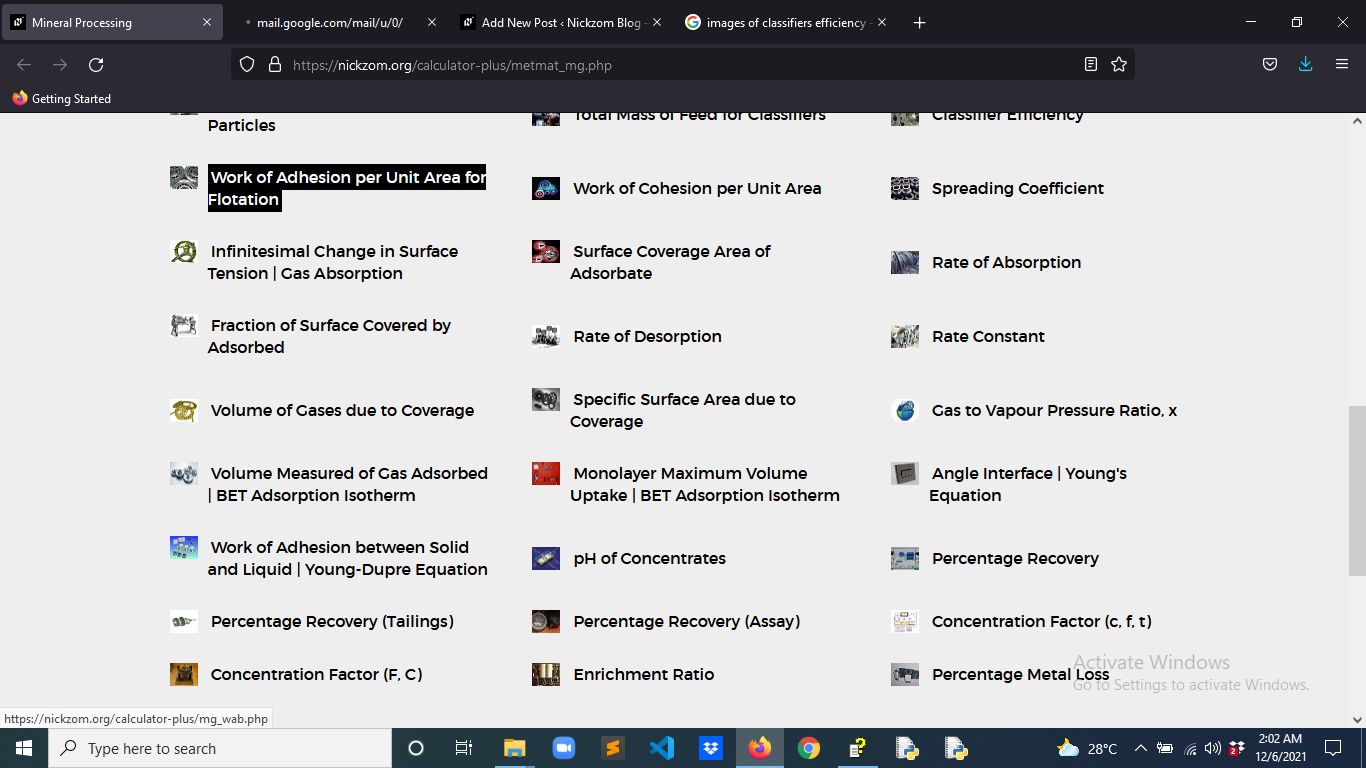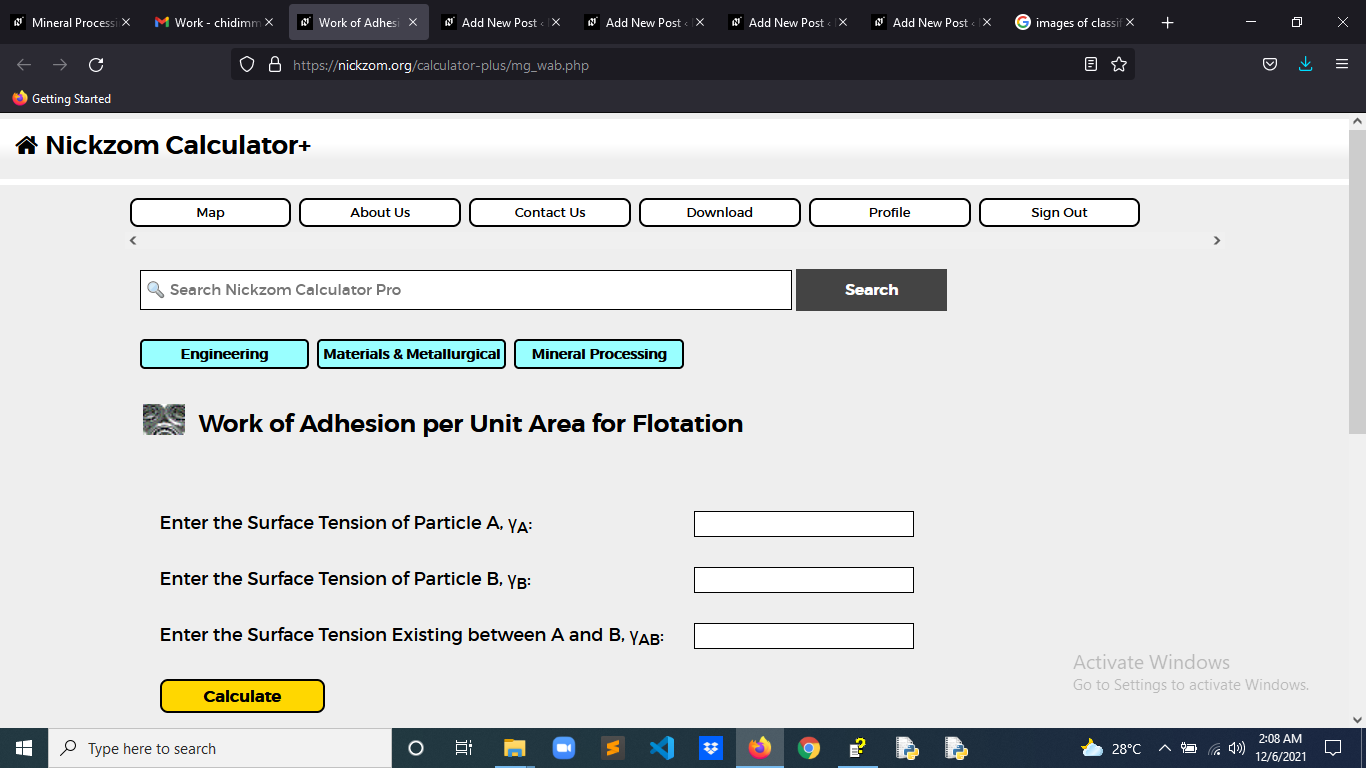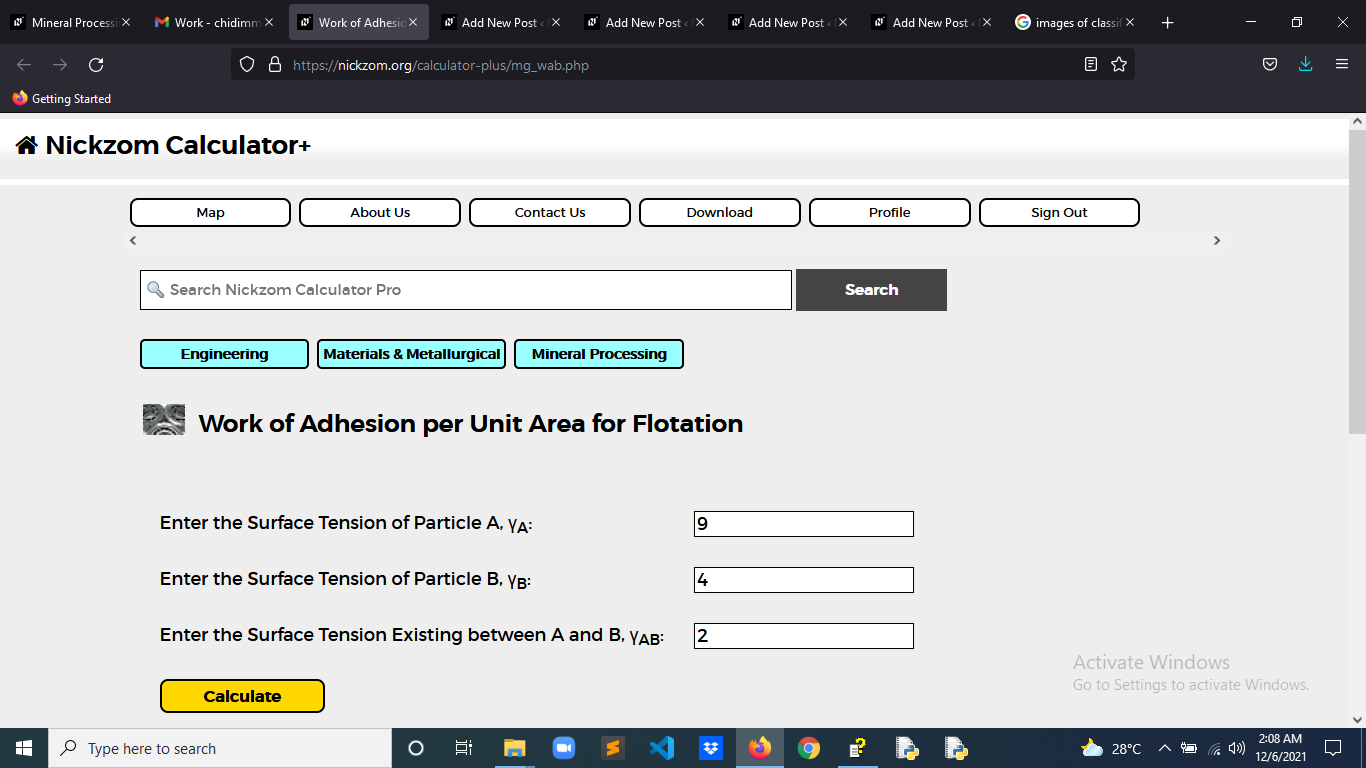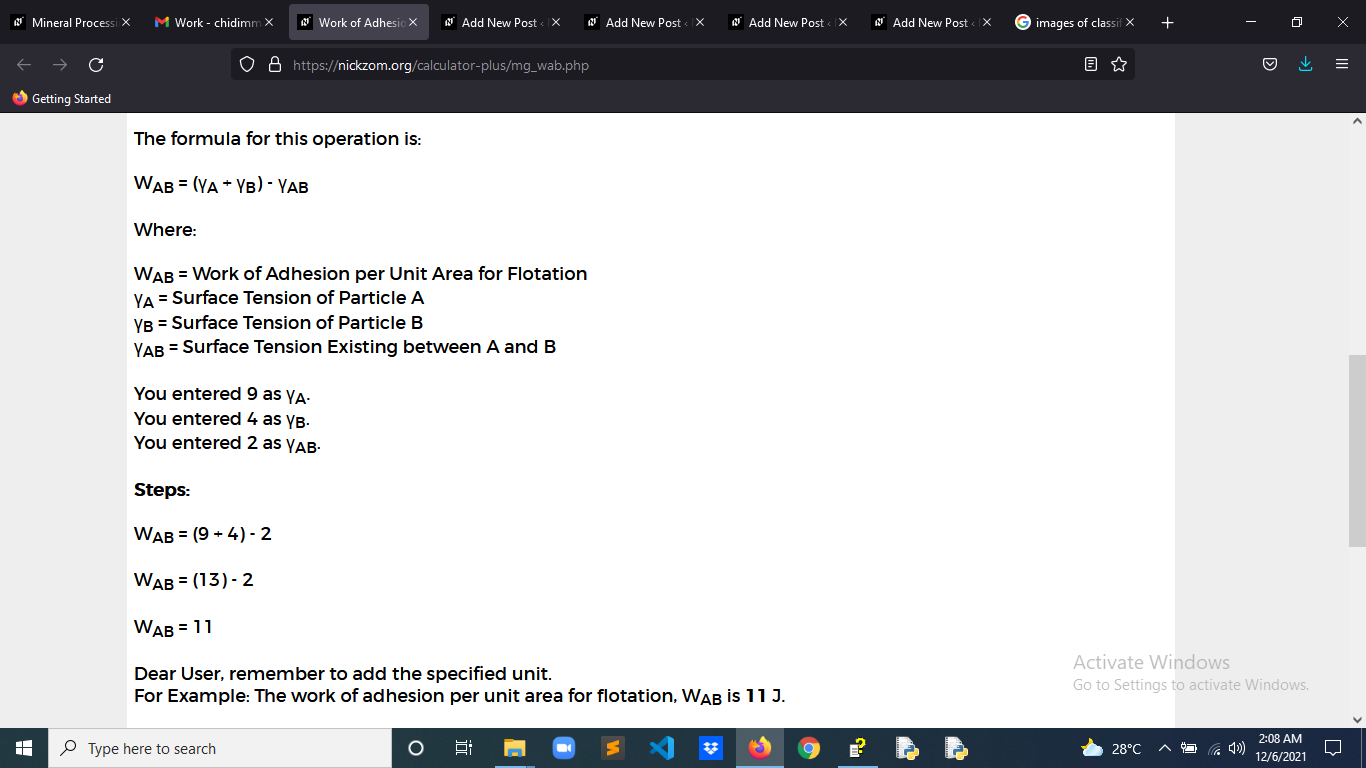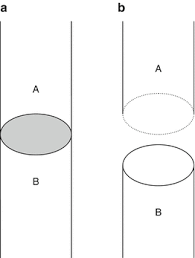
The image above represents work of adhesion per unit area for flotation. To calculate work of adhesion per unit area for flotation, three essential parameters are needed and these parameters are Surface Tension of Particle A, (γA), Surface Tension of Particle B, (γB) and Surface Tension Existing between A and B, (γAB).
The formula for calculating work of adhesion per unit area for flotation:
WAB = (γA + γB) – γAB
Where:
WAB = Work of Adhesion per Unit Area for Flotation
γA = Surface Tension of Particle A
γB = Surface Tension of Particle B
And then, γAB = Surface Tension Existing between A and B
Let’s solve an example;
Find the work of adhesion per unit area for flotation when the surface tension of particle is 9, the surface tension of particle is 4 and the surface tension existing between A and B is 2.
This implies that;
γA = Surface Tension of Particle A = 9
γB = Surface Tension of Particle B = 4
And then, γAB = Surface Tension Existing between A and B = 2
WAB = (γA + γB) – γAB
That is, WAB = (9 + 4) – 2
WAB = (13) – 2
WAB = 11
Therefore, the work of adhesion per unit area for flotation is 11 J.
Calculating the Surface Tension of Particle A when the Work of Adhesion per Unit Area for Flotation, the Surface Tension of Particle B and the Surface Tension Existing between A and B are Given.
γA = WAB + γAB – γB
Where:
γA = Surface Tension of Particle A
WAB = Work of Adhesion per Unit Area for Flotation
γB = Surface Tension of Particle B
γAB = Surface Tension Existing between A and B
Let’s solve an example;
Find the surface tension of particle A when the work of adhesion per unit area for flotation is 42, the surface tension of particle B is 10 and the surface tension existing between A and B is 8.
This implies that;
WAB = Work of Adhesion per Unit Area for Flotation = 42
γB = Surface Tension of Particle B = 10
γAB = Surface Tension Existing between A and B = 8
That is, γA = WAB + γAB – γB
γA = 42 + 8 – 10
γA = 40
Therefore, the surface tension of particle a is 40.
Read more: How to Calculate and Solve for Work of Cohesion Per Unit Area | Mineral Processing
Calculating the Surface Tension of Particle B when the Work of Adhesion per Unit Area for Flotation, the Surface Tension of Particle A and the Surface Tension Existing between A and B are Given
γB = WAB + γAB – γA
Where:
γB = Surface Tension of Particle B
WAB = Work of Adhesion per Unit Area for Flotation
γA = Surface Tension of Particle A
γAB = Surface Tension Existing between A and B
Let’s solve an example;
Find the surface tension of particle B when the work of adhesion per unit area for flotation is 25, the surface tension of particle A is 12 and the surface tension existing between A and B is 10.
This implies that;
WAB = Work of Adhesion per Unit Area for Flotation = 25
γA = Surface Tension of Particle A = 12
γAB = Surface Tension Existing between A and B = 10
That is, γB = WAB + γAB – γA
γB = 25 + 10 – 12
γB = 23
Therefore, the surface tension of particle B is 23.
Calculating the Surface Tension Existing between A and B when the Work of Adhesion per Unit Area for Flotation, the Surface Tension of Particle A and the Surface Tension of Particle B are Given
γAB = γA + γB – WAB
Where:
γAB = Surface Tension Existing between A and B
WAB = Work of Adhesion per Unit Area for Flotation
γA = Surface Tension of Particle A
γB = Surface Tension of Particle B
Master Calculations Instantly
Unlock solutions for math, physics, engineering, and chemistry problem with step-by-step clarity. No internet required. Just knowledge at your fingertips, anytime, anywhere.
Let’s solve an example;
Find the surface tension existing between A and B when the work of adhesion per unit area for flotation is 10, the surface tension of particle A is 20 and the surface tension of particle B is 14.
This implies that;
WAB = Work of Adhesion per Unit Area for Flotation = 10
γA = Surface Tension of Particle A = 20
γB = Surface Tension of Particle B = 14
So, γAB = γA + γB – WAB
γAB = 20 + 14 – 10
γAB = 24
Therefore, the surface tension existing between A and B is 24.
How to Calculate Work of Adhesion per Unit Area for Flotation With Nickzom Calculator
Nickzom Calculator – The Calculator Encyclopedia is capable of calculating the work adhesion per unit area for flotation.
To get the answer and workings of the work adhesion per unit area for flotation using the Nickzom Calculator – The Calculator Encyclopedia. First, you need to obtain the app.
You can get this app via any of these means:
Web – https://www.nickzom.org/calculator-plus
To get access to the professional version via web, you need to register and subscribe to have utter access to all functionalities.
You can also try the demo version via https://www.nickzom.org/calculator
Android (Paid) – https://play.google.com/store/apps/details?id=org.nickzom.nickzomcalculator
Android (Free) – https://play.google.com/store/apps/details?id=com.nickzom.nickzomcalculator
Apple (Paid) – https://itunes.apple.com/us/app/nickzom-calculator/id1331162702?mt=8
Once, you have obtained the calculator encyclopedia app, proceed to the Calculator Map, then click on Materials and Metallurgical under Engineering.
Now, Click on Mineral Processing under Materials and Metallurgical
Now, Click on Work Adhesion per Unit Area for Flotation under Mineral Processing
The screenshot below displays the page or activity to enter your values, to get the answer for the work adhesion per unit area for flotation according to the respective parameter which is the Surface Tension of Particle A, (γA), Surface Tension of Particle B, (γB) and Surface Tension Existing between A and B, (γAB).
Now, enter the values appropriately and accordingly for the parameters as required by the Surface Tension of Particle A, (γA) is 9, Surface Tension of Particle B, (γB) is 4 and Surface Tension Existing between A and B, (γAB) is 2.
Finally, Click on Calculate
As you can see from the screenshot above, Nickzom Calculator– The Calculator Encyclopedia solves for the work adhesion per unit area for flotation and presents the formula, workings and steps too.

